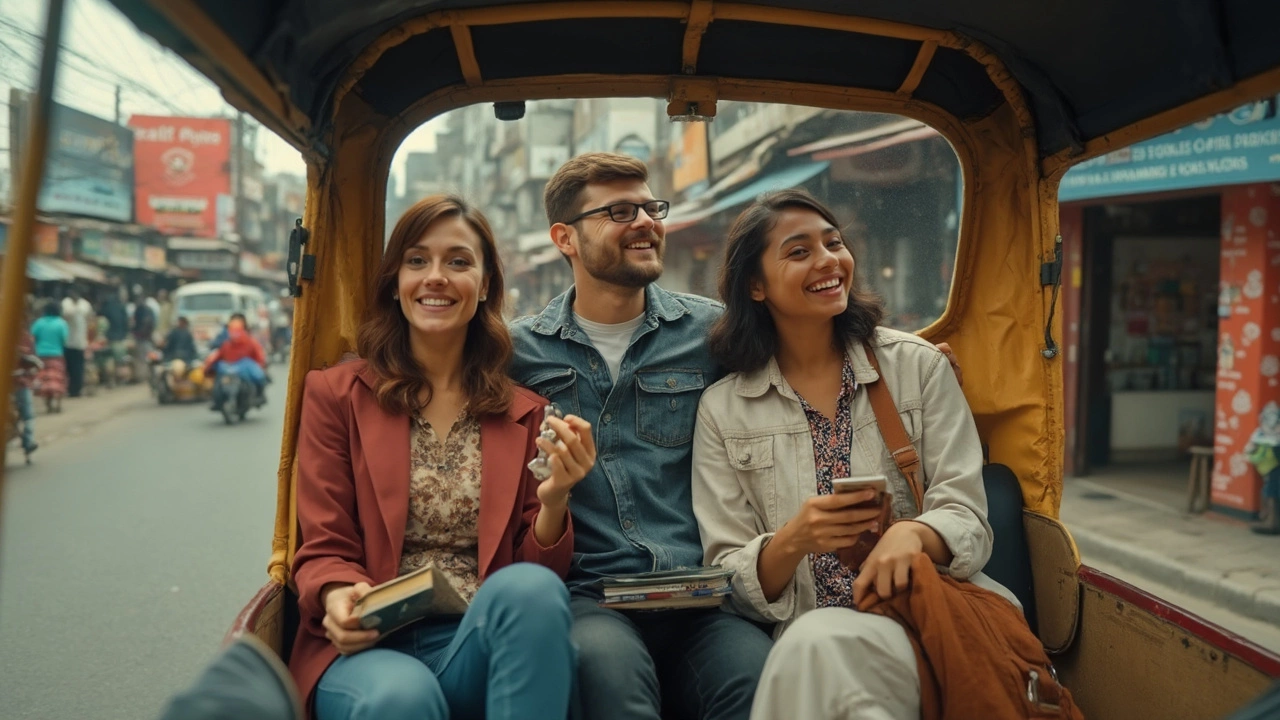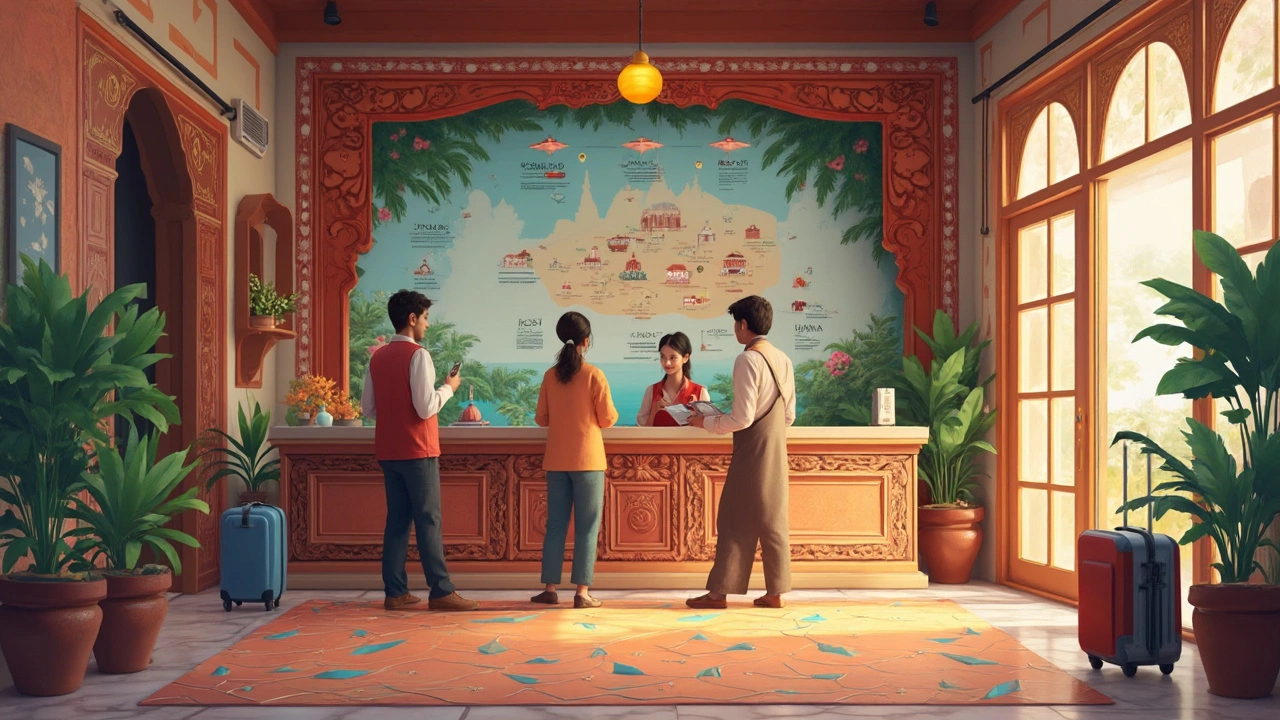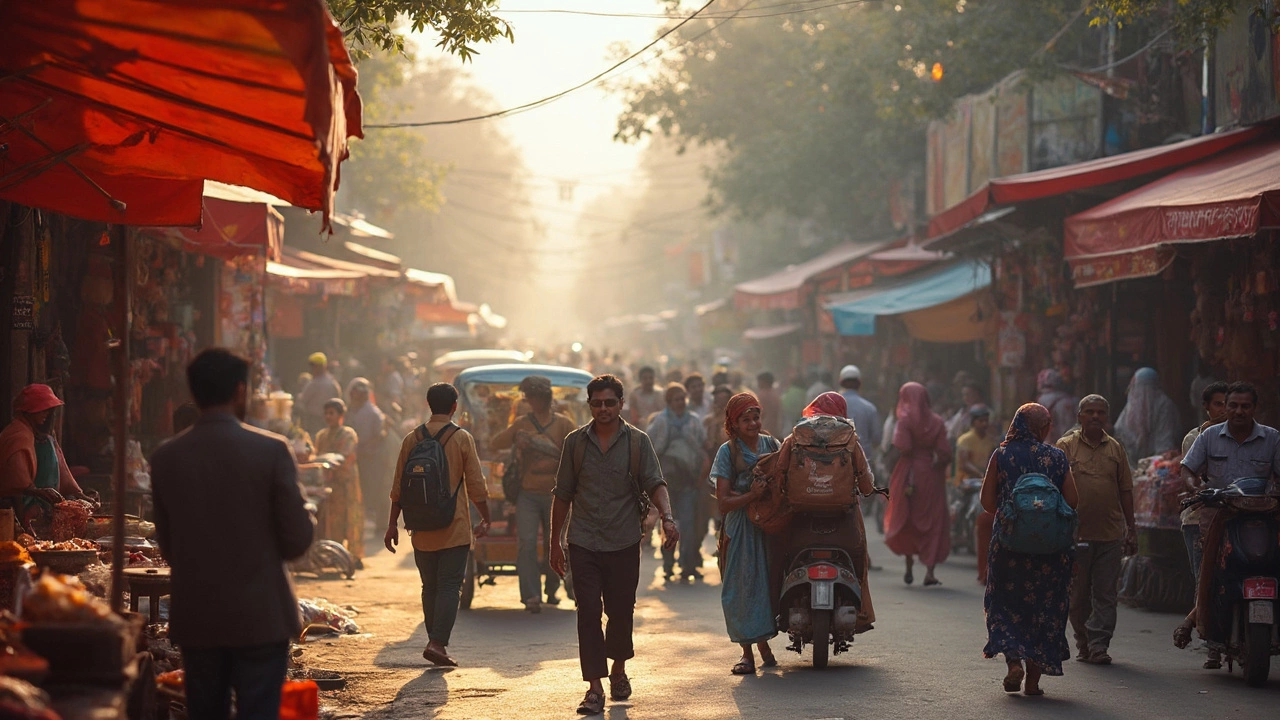Sticker shock hits some travelers the moment they Google flights to Delhi, but the real story isn't just in the airfare. India is famous for being both ridiculously cheap and sneakily expensive, depending on how and where you spend. Let’s say it upfront: you can blow $10 a day, or $1000—India welcomes both shoestring backpackers and luxury seekers.
What trips people up is not knowing where the costs add up. Sure, a street meal can cost less than a bottle of water back home, but splurging on a five-star palace or private driver can make you question if you’re still in a ‘budget’ destination. There aren’t fixed prices for travelers; the country flexes to your travel style.
The golden tip? Decide what you want out of your trip—then watch how your expenses shift. Transport, food, and hotels can balloon or shrink depending on your choices. Stick around as we bust myths, share real numbers, and reveal practical ways to stretch your rupees further. India can cost as much or as little as you let it.
- The Real Price of Getting Around
- Eating Well Without Emptying Your Wallet
- Where to Sleep: Hostels to Heritage Hotels
- Cultural Experiences: Free & Paid Gems
- Smart Saving Hacks for Every Traveler
The Real Price of Getting Around
Getting around in India can be a wild ride, but it definitely won’t eat up your entire budget—unless you’re rolling everywhere in air-conditioned private cars. Most travelers are surprised by how affordable public transport is. You can go hundreds of miles for what you’d pay for a city bus ride in the US or Europe.
Trains are the classic way to see huge chunks of the country. A sleeper class ticket from Delhi to Varanasi (about 850 km) costs around ₹500-₹600 (6 to 8 USD). For some comfort and AC, expect to pay ₹1,500-₹2,500 (18 to 30 USD). Booking directly from the official IRCTC website or app saves you the middleman fees. But India’s trains do sell out fast—so plan ahead if your dates aren’t flexible!
Buses fill the gap where trains don’t reach. For example, an overnight Volvo bus (with comfy seats and AC) from Delhi to Jaipur is about ₹700-₹1,200 (8 to 14 USD). Cheaper non-AC buses slice that cost in half. Just look at bus aggregator sites like Redbus to grab a clear deal without getting hustled at the last minute.
Inside cities, there’s a whole mix: metros in big towns, tuk-tuks (autos), Uber/Ola cabs, and good ol’ cycle rickshaws. A metro ride in Delhi, Mumbai, or Bangalore rarely goes above ₹50 (60 cents!). Autos use meters in theory, but expect to haggle out of tourist spots. For reference, a 5 km auto ride in a mid-sized city is usually ₹80-₹120 (about 1 to 1.50 USD).
Here’s a breakdown of typical costs for different ride options:
| Mode of Transport | Average Cost (₹) | Average Cost (USD) | Notes |
|---|---|---|---|
| Local city bus | 10 - 25 | 0.12 - 0.30 | Very basic but super cheap |
| Delhi Metro (max) | 60 | 0.72 | Safe, fast, air-conditioned |
| Uber/Ola (per km) | 15 - 20 | 0.18 - 0.24 | Check surge pricing |
| Auto Rickshaw (5 km) | 100 | 1.20 | Haggle or ask driver to use meter |
| Sleeper Train (long distance) | 500 - 600 | 6 - 8 | Book in advance for best prices |
A smart move: if you know you’ll jump from city to city, buy your train tickets as early as you can. Seat availability gets tight around Indian holidays and school breaks. For city transport, Google Maps is surprisingly up to date—use it to find metro or bus routes, and skip tourist scams.
Getting around India is not just affordable—it’s part of the adventure. Just keep small bills and coins handy, trust official apps, and for longer routes, splurge on AC class if you want to skip sticky heat and snoring neighbors.
The truth is, when you plan right, India travel cost for transport is one of the lowest for any big country. This leaves you with more cash to try new foods, shop, or do epic sightseeing. Not a bad deal.
Eating Well Without Emptying Your Wallet
Food is the real jackpot in India—delicious, endless variety, and you don’t need to fork out much. Some of the best bites you’ll have come from street vendors or tiny local joints called dhabas. For just 50 to 100 rupees (about $0.60 to $1.20), you can grab a hot plate of chole bhature or samosas with chutney. Sit-down restaurants aren’t going to bankrupt you either; a solid meal often stays under 300 rupees ($3.50) even in touristy areas.
If you’re worried about your stomach, pick places crowded with locals. That’s usually a green flag for tasty food and safe cooking. Big cities now have apps like Zomato and Swiggy that’ll bring everything from pizza to butter chicken right to your hotel, sometimes for less than what you'd pay at a restaurant back home.
- India travel cost drops big time if you eat like a local. International fast-food spots? Prices there are higher, and the taste isn’t why you came to India.
- Drinking bottled water is a must; buy 1-liter bottles for 20-30 rupees ($0.25-$0.35) almost anywhere.
- Don’t miss trying a basic vegetarian thali. You get rice, roti, dal, veggies, and maybe a sweet—all for 150 rupees ($1.80) or less. Unlimited refills are common.
Check out these average prices to get a feel for what you’ll spend on daily eats:
| Item | Average Price (INR) | Price in USD |
|---|---|---|
| Street Snack (Samosa/Pakora) | 20-40 | 0.24-0.50 |
| Dhaba Meal | 50-120 | 0.60-1.45 |
| Restaurant Lunch | 200-300 | 2.40-3.60 |
| Bottle of Water | 20-30 | 0.25-0.35 |
| Zomato Delivery (Meal) | 120-300 | 1.45-3.60 |
If you’re in big cities like Mumbai or Delhi, eating international or upscale can set you back 1500 rupees or more per meal, so know what you’re getting into. But mostly, food will be a highlight that’s easy on your wallet if you stick to what locals love.

Where to Sleep: Hostels to Heritage Hotels
Figuring out where to crash in India is half the fun—and half the battle of budgeting. You’ve got everything from dirt-cheap bunks in backpacker hostels to swanky royal palaces with butlers. Prices cover a wild range, and the cool part? Even at the lowest end, you’re rarely just settling for something basic. Kinda wild, right?
If you want rock-bottom prices, big cities like Delhi, Mumbai, and Bangalore have hostel dorms starting from as little as 400 INR (about $5) per night. These often include Wi-Fi, a common chill area, and sometimes free chai. Brands like Zostel are popular for young travelers and solo adventurers. Privacy’s key for you? Budget hotels and guesthouses can snag you a clean double room from about 800–2,000 INR ($10–$24) a night—look at online reviews and photos so you don’t get any nasty surprises.
On the other hand, some travelers come to India dreaming of princess-level pampering. Enter the heritage hotels—the old forts, havelis, and palaces turned into legit hotels. The Taj Lake Palace in Udaipur, with suite rates sometimes hitting $600+ per night, gives you views that look straight out of a movie. There’s also Neemrana Fort near Delhi (runs $120–$350 a night), which mixes history and comfort like nowhere else. The best part is these places throw in cultural shows, epic meals, and actual royal vibes in the package.
| Type | Budget per Night (INR) | Budget per Night (USD) |
|---|---|---|
| Hostels (Dorm Bed) | 400–700 | $5–$8 |
| Budget Hotel / Guesthouse | 800–2,000 | $10–$24 |
| Mid-range Hotel | 2,500–6,000 | $30–$72 |
| Heritage Hotel | 8,000–50,000 | $96–$600+ |
Quick tips for scoring sweet deals:
- Book online, but always double-check if direct booking with the hotel gets you a better rate.
- Off-season travel (think: April to September) means lower prices and fewer crowds everywhere.
- Read the recent reviews—last month’s feedback is worth more than a fancy photo.
- Don’t be afraid to negotiate at guesthouses, especially in smaller cities or outside of peak season.
Bottom line: whether you’re all about that hostel life or dreaming of palaces, India travel cost actually depends a ton on where you choose to sleep. With this much variety, it really comes down to what kind of adventure you want—and how much you want to spend for it.
Cultural Experiences: Free & Paid Gems
India's the kind of place where you can catch a festival in the street, join a walking tour for next to nothing, or fork over a pretty penny for a guided palace visit. A lot of the best moments won’t cost a thing—like watching sunrise on the ghats of Varanasi, or seeing spontaneous temple music in Chennai. Just pull up a step and take it in.
That being said, there are some cultural experiences where a little cash gives you access to something special. Here’s the lowdown on what’s free, what’s worth paying for, and where your money actually goes:
- India travel cost swings wildly when you add up paid attractions; for example, the Taj Mahal entry ticket for foreigners is INR 1,100 (about $13), and it’s totally worth the price. Many other UNESCO sites, like Qutub Minar or Mysore Palace, charge foreign visitor rates in the $5–10 range.
- Museums like Delhi’s National Museum or the Chhatrapati Shivaji Maharaj Vastu Sangrahalaya in Mumbai have entrance fees between INR 500–850 ($6–10), but the exhibits and artifacts are epic if you’re into history.
- Want something hands-on? Workshops run by NGOs (like block printing in Jaipur or cooking classes in Kochi) start around INR 800 ($10) and go up depending on group size and length.
- There’s no charge to stroll much of India’s historic old towns—think Mumbai’s Fort district, Kolkata’s College Street, or the alleys of Old Delhi—where daily life lets you peek at culture for free.
- If you’re there during a big festival (think Holi, Diwali, or Ganesh Chaturthi), joining the crowds costs nothing but can be messy, wild, and unforgettable. Just don’t wear your best clothes.
Here’s a quick look at typical entrance or tour fees:
| Experience | Cost (Foreigner, INR) | Approx USD |
|---|---|---|
| Taj Mahal ticket | 1,100 | $13 |
| Local walking tour | 500–1,000 | $6–12 |
| Cooking class | 1,000–2,000 | $12–24 |
| Museum entry | 500–850 | $6–10 |
| Street festival | Free | Free |
If you’re on a tight budget, just stick to the free stuff. But for unique memories, think about picking one or two paid experiences—you’ll get stories and skills that feel priceless.

Smart Saving Hacks for Every Traveler
Want to make your rupees last on your trip? Good news: India’s full of budget tricks that work for everyone, no matter your travel style. You don’t have to eat instant noodles or skip the good stuff. A little planning beats overspending every time.
- India travel cost can drop hard if you book trains early. Indians use the IRCTC site or app for tickets—sleeper or third AC classes are comfy and let you see more countryside. For buses, RedBus and state-run options (like KSRTC in Kerala) are cheaper than flights for under-1,000 km routes.
- Want great food but not a big bill? Ditch tourist restaurants and go where locals eat. Thali lunches—a plate with rice, dal, veggies, bread, and pickles—rarely cost over $2-$3, even in cities. South Indian dosa joints or small dhabas on highways are wallet-friendly and authentic.
- Accommodations eat up the biggest chunk of money, but you’re spoiled for choice. Hostels are everywhere now—think Zostel or Backpacker Panda. In popular spots, dorm beds start at $4 per night. If you treat yourself to a fancier hotel, check for deals on MakeMyTrip or Agoda; prices swing a ton by season.
- Buying a local SIM saves cash if you’re staying more than a week. Look for Airtel or Jio stores in airports or big towns. Mobile data’s cheap—about $3 gets you 1.5GB a day for 28 days—so skip roaming charges and use Uber, Google Maps, and digital payments.
- Bargain at markets, but know your limits. Haggling is normal, but polite. If you’re unsure, ask your hotel for price estimates first. For fixed price shopping, hit up government emporiums.
Here’s what different daily budgets often look like for travelers, based on 2025 rates:
| Style | INR per day | USD per day | What’s Included |
|---|---|---|---|
| Shoestring | 1,200–2,000 | ~$15–$25 | Hostels, local meals, buses/trains |
| Mid-range | 3,500–6,000 | ~$40–$70 | Good hotels, AC trains/taxis, entry fees, nice restaurants |
| Luxury | 12,000+ | $140+ | 5-star hotels, private car/driver, premium tours |
A final tip—carry a little cash for temples, transport, or street food, but use UPI (digital payment apps) for most things. Even rickshaw drivers take it now. By being clear on what matters most to you, knowing where to save and where to splurge, you’ll get way more out of every rupee spent.
